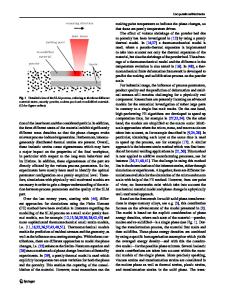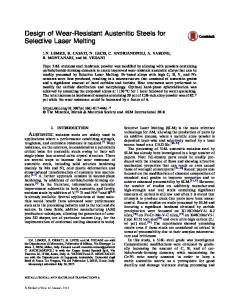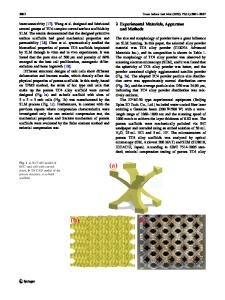Selective Laser Melting
Lasers are employed for manufacturing (laser manufacturing) in a wide variety of applications, including shape control of metal materials by laser processing and welding, as well as modification of microstructure and functionality through laser quenching.
- PDF / 12,038,790 Bytes
- 173 Pages / 453.543 x 683.15 pts Page_size
- 68 Downloads / 358 Views
Multi-dimensional Additive Manufacturing
Multi-dimensional Additive Manufacturing
Soshu Kirihara Kazuhiro Nakata •
Editors
Multi-dimensional Additive Manufacturing
123
Editors Soshu Kirihara JWRI Osaka University Osaka, Japan
Kazuhiro Nakata JWRI Osaka University Osaka, Japan
ISBN 978-981-15-7909-7 ISBN 978-981-15-7910-3 https://doi.org/10.1007/978-981-15-7910-3
(eBook)
© The Japan Welding Engineering Society 2021 This work is subject to copyright. All rights are solely and exclusively licensed by the Publisher, whether the whole or part of the material is concerned, specifically the rights of translation, reprinting, reuse of illustrations, recitation, broadcasting, reproduction on microfilms or in any other physical way, and transmission or information storage and retrieval, electronic adaptation, computer software, or by similar or dissimilar methodology now known or hereafter developed. The use of general descriptive names, registered names, trademarks, service marks, etc. in this publication does not imply, even in the absence of a specific statement, that such names are exempt from the relevant protective laws and regulations and therefore free for general use. The publisher, the authors and the editors are safe to assume that the advice and information in this book are believed to be true and accurate at the date of publication. Neither the publisher nor the authors or the editors give a warranty, expressed or implied, with respect to the material contained herein or for any errors or omissions that may have been made. The publisher remains neutral with regard to jurisdictional claims in published maps and institutional affiliations. This Springer imprint is published by the registered company Springer Nature Singapore Pte Ltd. The registered company address is: 152 Beach Road, #21-01/04 Gateway East, Singapore 189721, Singapore
Preface
Technologies that confer different properties or functions to the surface of a material have long existed. These technologies have been known by terms such as “surface treatments” and “surface technologies,” which include plating and conversion coating, or “surface heat treatments,” which include carburizing and nitriding. In approximately 1990, a new term, “surface modification,” arrived in Japan from the West. This accompanied the commercialization of new ceramic thin film coating technologies (CVD, PVD) and was intended either to unite these technologies or to differentiate them from the conventional technologies. To accommodate this new technological trend, the Surface Modification Research and Technology Committee was established by the Japan Welding Engineering Society (JWES) in 1989. The committee added thin film coating technologies to conventional surface technologies as well as thick film surface technologies, such as the welding techniques of thermal spraying and hardfacing/ cladding. The committee continues to be active to this day. Recently, the new terms of “3D printing technology” and “additive manufacturing (AM)” arrived in Japan from the West. 3D printin
Data Loading...











